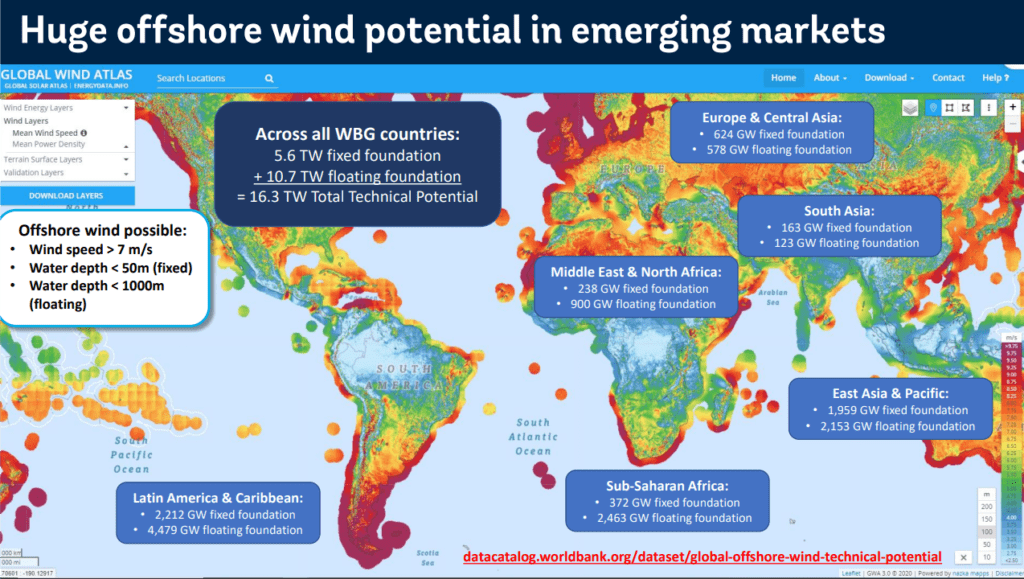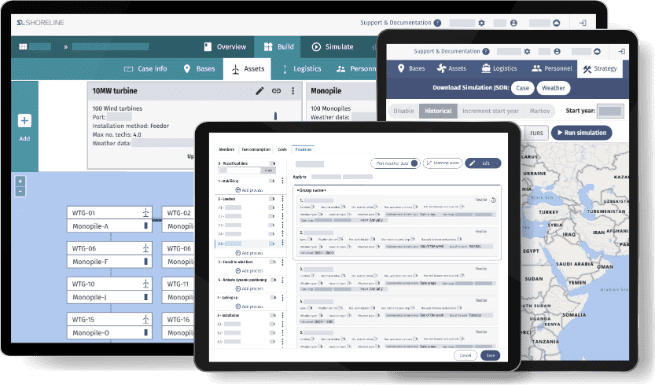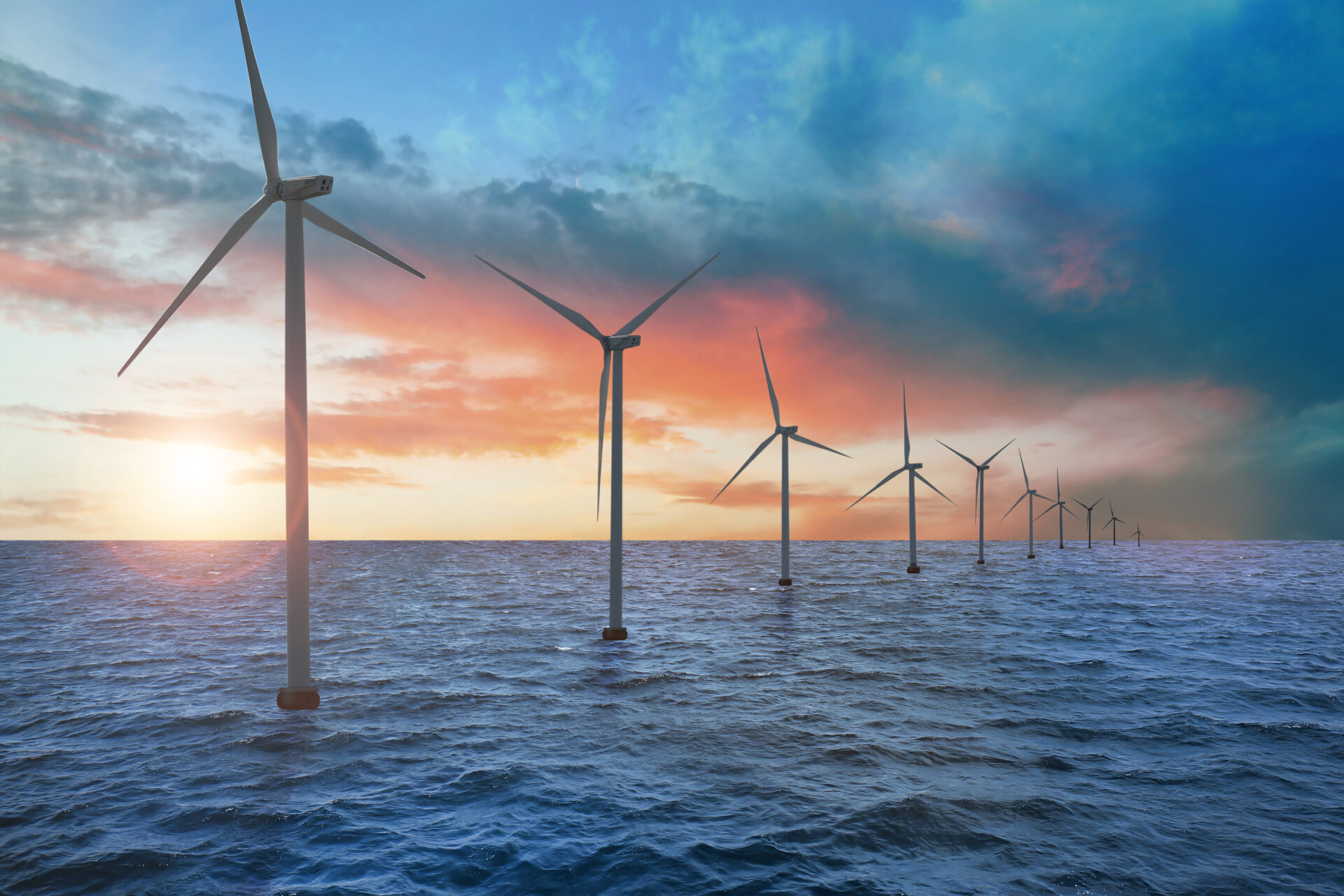Growth of new wind farm installations in planning and early-phase offshore wind development.
After years of relatively slow growth outside of Europe, the energy crisis and increasing calls to action regarding climate change are sparking global interest in new offshore wind developments. Worldwide, an increasing number of new installations are in the planning or early-phase offshore wind development stage, and expectations are high for future projects. According to one estimate, global offshore wind installations are projected to deliver 630 gigawatts (GW) by 2050 – an exponential increase over the current 40 GW being produced.

Despite the enormous combined market potential – valued to reach $56.8 billion by 2026 – emerging markets often face regulatory, infrastructure, supply-side, and even political obstacles to overcome.
Difficulties and challenges aside, developers and planners are full steam ahead in increasing offshore capacity in emerging markets, as highlighted in the above graph for the potential of offshore wind in emerging markets.
Technological advances in the wind industry increase energy efficiency and deployment challenges.
If there ever was a time for a global scaleup, the time is now. Technological advances in wind turbine, size, speed, and power ratings have made today’s turbines capable of significantly more megawatt generation than earlier models. The efficiency is expected to steadily increase over the next five to ten years. These improvements are, in turn, reducing the levelized cost of electricity (LCOE) — meaning more electricity can be produced for far less per turbine.
Alongside increases in power production, turbine placement is also undergoing a significant transformation with floating turbine technology making installations in depths up to 1000m possible — extending way beyond the range of traditional, bottom-fixed installations that are limited to depths up to 50m. Future renewable energy technology also includes great potentials for excess wind storage and conversion technologies, such as hydrogen electrolysis and Power-to-X, that while in their infancy, demonstrate their potential to offset the impact of carbon-heavy transport significantly.
Despite their massive potential, aside from the more predictable obstacles in emerging markets, including challenges with grid connections, port infrastructure and production facilities, new markets often lack the regulatory framework of more established markets.
And for many companies, the early-phase offshore wind market represents a paradigm shift in terms of how to anticipate future conditions and plan on a global scale. In order to come up to speed under fast-changing rules, regulations, and supply chains, companies will need to learn fast on the curve, and remain adaptable throughout the entire planning process. Early-site developers will need to adopt a more holistic approach to project planning, as planners that can account for supply chain interdependencies are better positioned to create reliable business cases.
It then comes as no surprise to any site planner that the better the prediction, the better the outcome. But given so many moving parts and varying regulations and conditions, how can early-site planners create accurate forecast models?
Simulate complex scenarios to predict installation time and O&M costs in early-phase offshore wind markets.
Early-phase planning, with its even more complex supply chain, stands to especially benefit from advanced modeling software that can deliver actionable operations and resource optimization insights.
Advanced simulation technologies are becoming the industry standard tools for solving installation and maintenance operations by providing precise forecasting data. Offshore wind operators that have adopted intelligent, enterprise software-as-service solutions (SaaS) to accurately plan, model, and simulate offshore projects are key in driving down costs.
With Shoreline Wind’s software, users can quickly discover new early-phase strategies for modeling and simulating large and complex offshore wind farm projects. Here they can add their in-use assets to create complex scenarios to predict the time of a complete installation, asset downtime causes, vessel utilization, time-based availability and much more.

When building a digital model of a potential wind farm project, key components to research during early-phase development include factors such as infrastructure, logistics, weather downtime, project scheduling, contracting and cost. Since all these components have a high impact on the overall financial model, there is great benefit in optimizing these through multiple simulation runs and continuously feeding reliable data into the actual costs of building and operating a wind farm.
Shoreline is seeing a significant growth in the number of users exploring the deployment of wind farm projects at an earlier stage than we have experienced before. Users can start modeling at any given global location, which allows them to use the software for quickly assessing complex supply chain, field service and logistic scenarios from pre-assembly and load-out, to installation, commissioning, and maintenance. Within minutes, users can build a digital twin that can be simulated in many different campaigns, with various weather windows, alternative port installation logistics, different project start-dates and many more variations that provide project planners with a tool for constantly fine-tuning optimal data outputs for construction and O&M strategies as early as possible.
From there, the cases can be continuously developed in collaboration with EPC, contractors, developers, and other relevant stakeholders for building wind projects with actual data, which is widely used for tender preparation and submitting bids for wind auctions with optimized project cases regarding installation, O&M and financial aspects.
If you want to explore early-phase scenarios in our Design software, you can download our webinar “Early-stage strategies for new offshore wind market success”, or sign up for a product walk-through, where we will introduce you to the software based on your wind project.
We will also be exhibiting at Global Offshore Wind 2023 in London on 14-15 June. You can meet us at the Danish Pavilion, booth F60, where we will showcase our latest solutions and technology improvements.
If you have further questions regarding the article, please reach out to Michael Bjerrum, CCO & Co-Founder at Shoreline Wind: +45 6030 3777 or bjerrum@shoreline.no


